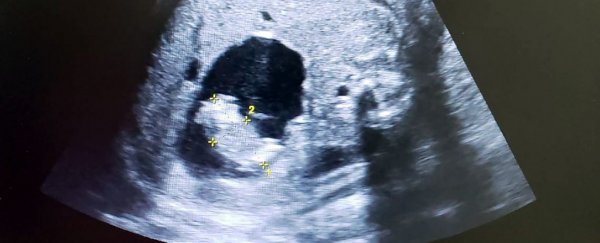A young Colombian child by the name of Itzamara Vega already has the whole world talking about her, and she was only born in February.
At just 35 weeks of age, still nestled in her mother's womb, Itzamara was diagnosed with an incredibly rare condition - one that's been recorded less than two hundred times.
Hiding within her abdomen, and only visible using advanced ultrasound techniques, doctors discovered the growing foetus of Itzamara's own twin sister.
Supported by an entirely separate umbilical cord, this foetus was actually drawing blood from its larger sibling's intestine like a parasitic twin, according to a report in The New York Times.
It sounds impossible, but it's true. First described in 1808, the congenital anomaly, known as foetus-in-fetu (aka fetus within fetus), occurs incredibly infrequently, something like one in every 500,000 births. So whenever it does crop up, it usually captures worldwide attention.
In the past, similar cases have described partially-formed foetuses with their own limbs, kidneys, spines, hair, fingernails, even a developed penis that could produce urine all on its own.
Usually marked by a bulge in the tummy of the newborn, most of the time this condition is picked up early on in life, but sometimes it can go undetected for years.
In one such case, a middle-aged woman found out that she had been unknowingly carrying her twin's eye, tooth and black hair in a tumour on her ovary for 45 years.
But as terrifying as this sounds, these so-called parasitic twins are benign and not actually alive. While the exact cause of such events is still not fully understood, the basic steps are as follows.
Early on in an identical twin pregnancy, when a single fertilised egg splits into two, the separated cells can sometimes divide unequally.
At first, nothing appears abnormal and both of these flat sheets of cells continue to grow normally. The problem only occurs around four weeks in, when the discs begin to fold and slowly form all of the body's necessities.
During this stage, if these twin embryos only partially divide, the cells of one can actually get engulfed by the other, like chocolate folded into cookie dough (sorry).
Tucked into the other foetus, the smaller twin is thus cut off from its mother's bloody supply and is forced to draw on its own sibling's blood for growth.
Believe it or not, it's even possible for more than one foetus to get wrapped up in this mess. In one remarkable case, 11 of these parasitic twins were found folded into one single foetus.
Of course, in Itzamara's case there was only one. Roughly five centimetres long (two inches), this parasitic foetus is reported to have contained a rudimentary head and limbs, without a brain or a heart.
Discovered at an unusually young stage, the case is a testament to modern medicine and its identification of high-risk pregnancies. Itzamara was delivered by an early C-section as the doctors were concerned the parasitic twin might crush her abdominal organs.
In the end, the growth was successfully removed just one day after the tiny girl's birth via a small incision, and the baby herself is doing just fine.
